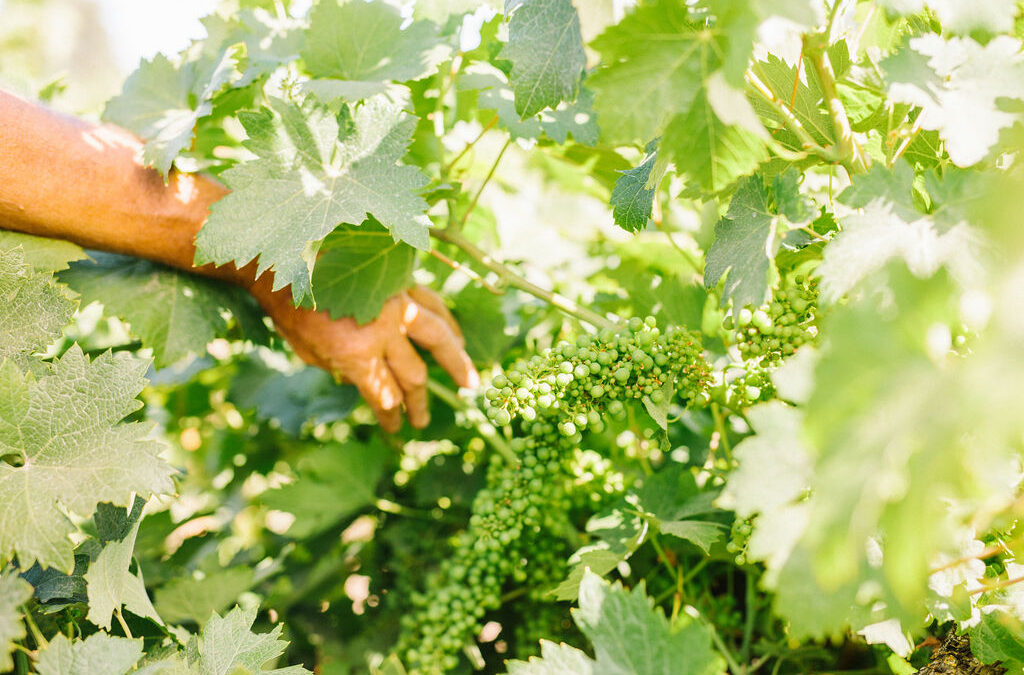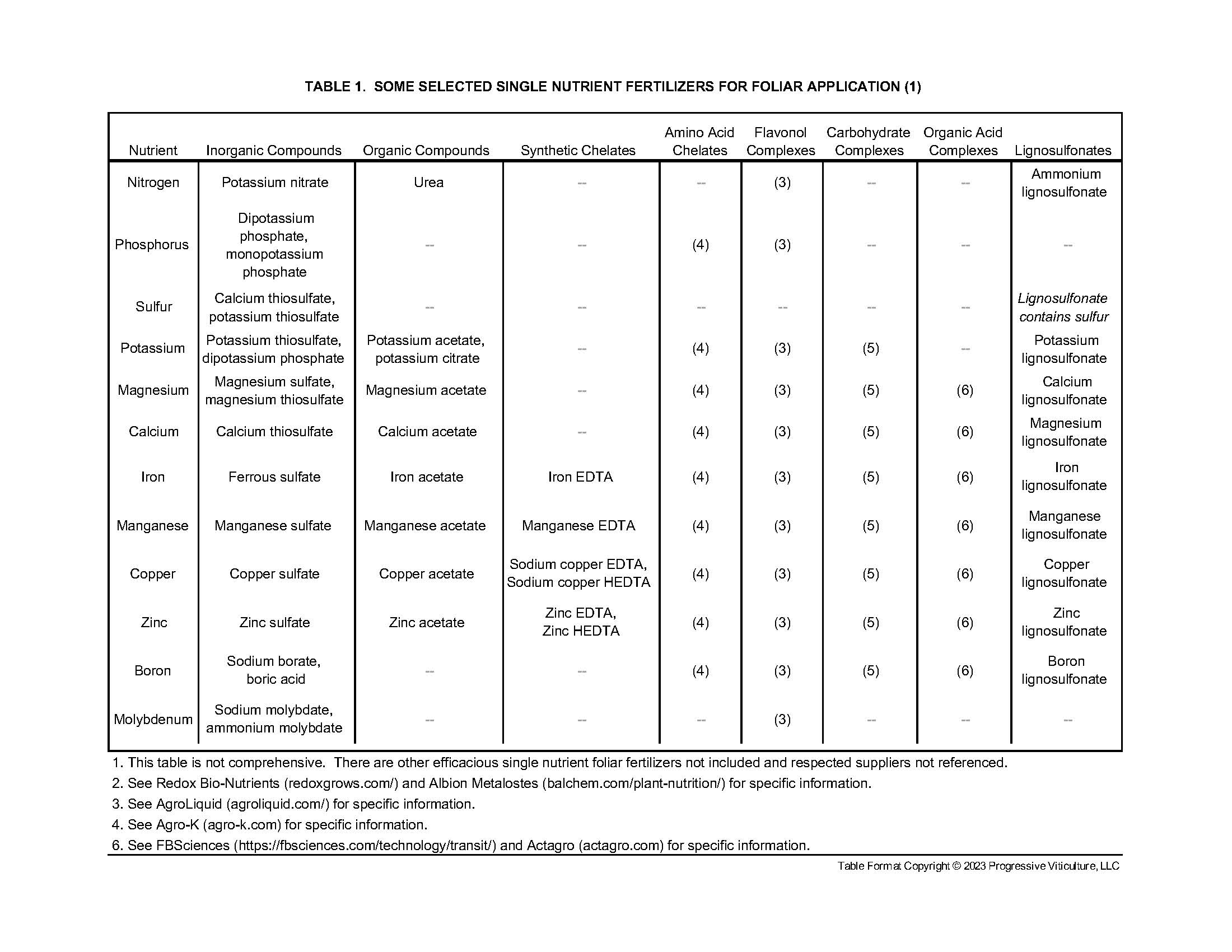MONDAY, MAY 8, 2023. BY STAN GRANT, VITICULTURIST.
Grapevine roots take up mineral nutrients from vineyard soils, the primary source of nutrients, to meet the demand for growth and development. Root uptake generally works well for vines, but there are times and situations where it underdelivers for commercial winegrape production. In these cases, applications of mineral nutrients to vine foliage can offset a shortage in the supply coming from the roots (Figure 1). In addition, certain foliar fertilizers applied at the proper time can stimulate metabolism in vines to enhance production and reduce stress. Due to these capabilities, foliar fertilization is an important element of modern vineyard management.
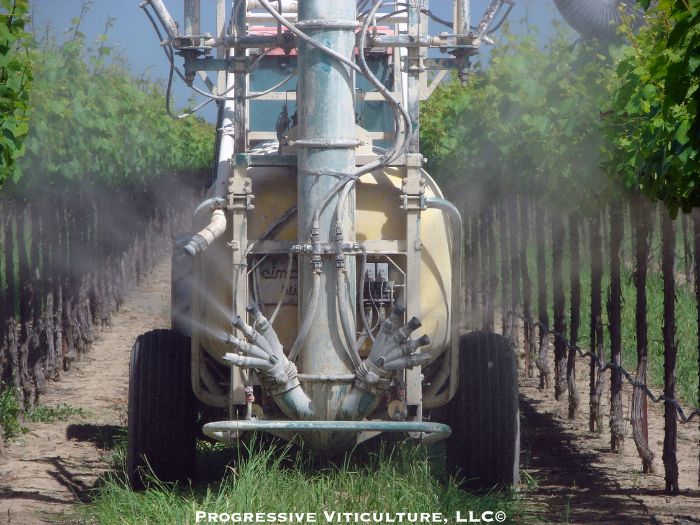
Figure 1. Fertilizers applied to grapevine foliage can offset a shortage in the supply taken up by roots. (Photo Source: Progressive Viticulture, LLC©)
After penetrating the outer protective layer of foliage tissues (the cuticle), cells quickly absorb and utilize foliar-applied nutrients. The rate of uptake is particularly rapid when leaf nutrient levels are low and due to the negative charge of the small pores in leaves, for small positive and neutral charged minerals. In fact, grapevine shoot responses to foliar fertilizers are often more rapid than to soil-applied fertilizers.
WHERE AND WHEN TO APPLY FOLIAR FERTILIZER
While foliar fertilization has the potential to be beneficial at any time, it is usually most cost-effective at specific times during the growing season and under certain environmental conditions. Some such instances are presented below.
NUTRIENT DEFICIENCY RAPID RESPONSE
Due to the swiftness of vine response to foliar fertilizers, they are an expedient option for arresting newly observed nutrient deficiency symptoms on vine foliage. There are, however, two situations in which a single foliar fertilizer application may not provide season-long deficiency correction. One involves nutrients with limited mobility in shoot tissues, such as calcium and iron. The other involves nutrients in high demand in grapevines that cannot be safely applied in the required quantities, including macronutrients such as potassium. The exception may be low biuret urea foliar applied to correct a nitrogen deficiency in some vineyards with small vines and light crop loads.
RESTRICTED ROOTS
When soil factors compromise roots, foliar fertilizers can provide nutrients needed in shoots. Examples include the inhibitory effects of cool soils early in the growing season, excessively wet soils, and soil-borne pests on roots.
UNFAVORABLE SOIL CHEMISTRY
For certain soils, which have chemistries that favor reactions that easily render some nutrients unavailable to roots, fertilizers applied to foliage can be more efficient than fertilizers applied to the soil. Iron and zinc in vineyards on strongly alkaline soils are such cases.
EXCESS COMPETITIVE MINERALS
Foliar fertilization is also useful for supplying a mineral nutrient where a competitive nutrient is present in overabundance in the vineyard soil. This is relevant for supplying potassium in certain California vineyards soils excessively high in magnesium.
FARMING WITHOUT IRRIGATION
For non-irrigated vineyards, foliar fertilization is the only option for effective in-season mineral nutrient applications (Figure 2). Without irrigation, limited soil water restricts both the availability and the movement of mineral nutrients within root zones. Correspondingly, the demand for some nutrients exceeds root uptake. Late-season foliar applied potassium to advance sugar accumulation in the berries of dry-farmed vineyards addresses such a situation.
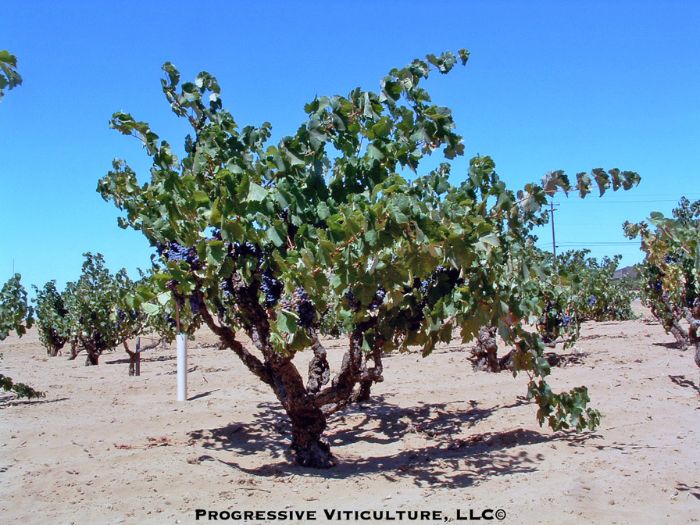
Figure 2. Foliar fertilization is the only option for applying readily available mineral nutrients to non-irrigated grapevines during the growing season. (Photo Source: Progressive Viticulture, LLC©)
TRANSITIONAL PHENOLOGICAL STAGES
During the transitional stages of grapevine development, there is a spike in the demand for certain minerals. Research has shown, even when ample nutrient is available in the soil and roots are functioning normally, shoots benefit from supplemental nutrients foliar applied during these phenological spikes. Boron during early bloom is a documented example.
INCREASING FRUIT YAN AND BUD BORON
Between bloom and veraison, foliar applied low biuret urea can increase the concentration of yeast assimilable nitrogen (YAN) in berries. This response may more reflect a nitrogen supply deficit following large-scale consumption in developing leaves than a demand spike in berries. After harvest, liberal rates of foliar applied boron increases boron in buds, which promotes normal fruit set the following year.
FOLIAR FERTLIZIER OPTIONS
In the early days of grapevine foliar fertilization, the micronutrients zinc and boron were the primary focus. During this time, the particle size and solubility of the inorganic compounds used as fertilizers were primary determinants of efficacy. Some inorganic salts, such as sodium borate (Solubor) are still commonly used (Table 1).
Later, inorganic chelates such as EDTA enhanced nutrient availability, but in most cases, not foliar absorptivity. For this reason, they are mainly used for soil fertilizer rather than foliar fertilizer applications.
Formulations involving micron-sized oxide and carbonate particles combined with adjuvant materials were an important step forward for foliar fertilizer effectiveness. The very small particle size enhanced uptake, and the adjuvants helped the particles spread across and adhere to leaf surfaces. Fertilizers containing calcium, magnesium, and phosphorus were among these formulations.
More recently, fertilizers incorporating mineral nutrients with amino acid chelates, flavanol chelates, carbohydrate complexes, and organic acid complexes became available. Most suppliers of these fertilizers have formulations allowed for organic certification and many are highly efficacious when applied at comparatively low rates. Still, other foliar fertilizers use citrate, lignosulfonate, or phosphite as carriers.
Foliar fertilizers containing combinations of three or more mineral nutrients are also commonly available. Some address specific nutritional needs, like the combination of mineral nutrients involved in pollination and fruit set.
Low biuret urea and potassium nitrate are perhaps the two most commonly foliar-applied nitrogen fertilizers in vineyards. Low biuret urea is a low-cost, highly efficient organic compound that can be safely applied at comparatively high rates. Nickel is a cofactor for urea metabolism and there may be instances in which simultaneous application of nickel and urea will enhance fertilizer performance. In some crops, potassium nitrate is known to suppress pest mites, which makes it an attractive option for early-season application. Later in the season, foliar potassium nitrate can delay sugar accumulation in berries.
APPLYING FOLIAR FERTILIZERS
Foliar fertilization shares the inefficiencies and risks associated with any foliar spray. These include those associated with incomplete coverage, excessive runoff related to the hydrophobic nature of leaf surfaces, rapid drying under warm air temperatures, washing off during rains, and toxicity when spray solutions are too concentrated. Foliar fertilization has the additional challenge of slowing absorption as shoot tissues age, cuticles thicken, and metabolism slows (Figure 3). These late-season developments coincide with decreased root activity and an increased potential benefit from foliar fertilization.
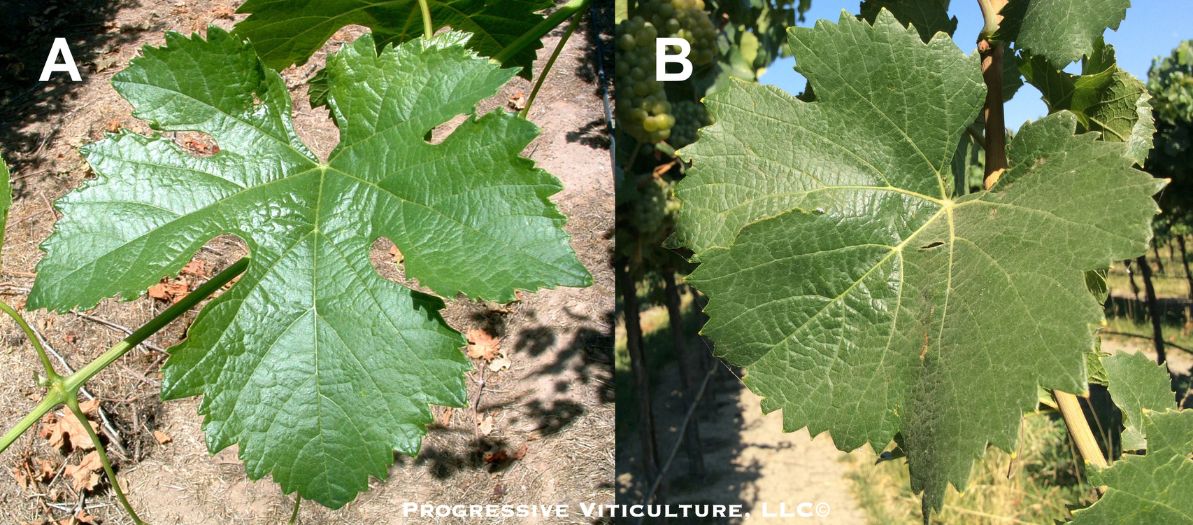
Figure 3. Canopies composed of older leaves (B) may require higher foliar fertilizer application rates than those composed of younger leaves (A) due to thicker cuticles and slower metabolism.
Favorable factors for foliar fertilization effectiveness include temperatures less than 85oF, relative humidity greater than 70%, wind speed less than 5 miles per hour, an appropriate spray adjuvant, well-positioned spray nozzles, and a properly calibrated sprayer. Favorable environmental conditions often occur while the sun is down. For maximum efficacy, late-season foliar fertilizer application rates may need to be greater than early-season applications to accommodate tissue aging. Importantly, complete canopy coverage is essential for the maximum benefit of foliar fertilization (Figure 4).
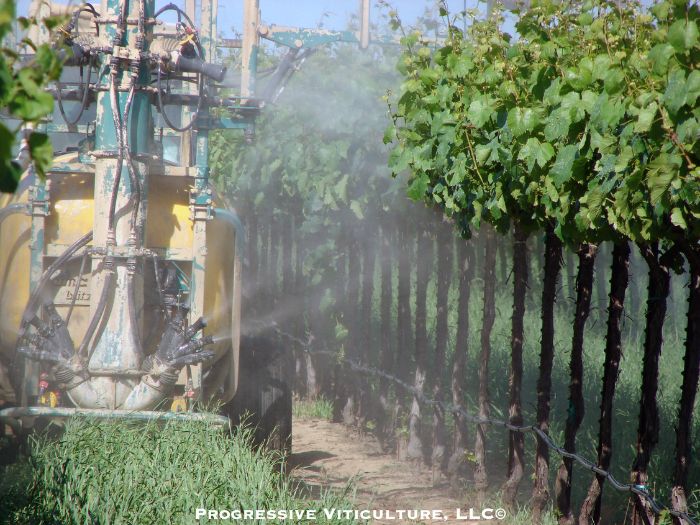
Figure 4. Complete canopy spray coverage is one of the keys to success for foliar fertilization. (Photo Source: Progressive Viticulture, LLC©)
IN SUMMARY
Advances in foliar fertilizer formulations, a better understanding of the workings of foliar applied mineral nutrients, and recognition of specific benefits of foliar fertilization have increased their importance to modern winegrape growing. Consequently, foliar fertilization has become an important counterpart to soil-applied fertilization methods in many vineyards. Careful spray application under favorable conditions is essential for achieving the greatest possible return on foliar fertilizer investments.
A version of this article was originally published in the Mid Valley Agricultural Services March 2002 newsletter and was updated for this blog post.
Further Reading
Amiri, ME. Accumulation of calcium by ripening berries on grape (Vitis vinifera L. cv. Asgari). The Proceedings of the International Plant Nutrition Colloquium XVI. UC Davis. 2009.
Anonymous. When foliar fertilization makes sense. Crop and Soils Magazine. American Society of Agronomy. March – April 2010.
Ashmead, HD, Ashmead, HH, Miller, GW, and Hsu, H-H (eds.). Foliar feeding of plants with amino acid chelates. Noyes Publications. Park Ridge, NJ. 1986.
Brown, P. Can boron correct transient nutrient deficiencies? Fluid Journal. pp. 1-3. Summer 2001.
Brown, PH. Nutrient demand and fertilization strategies: lessons learned from boron. In Conference proceedings: California Plant and Soil Conference. Modesto, Calif. California Chapter of the American Society for Agronomy. pp. 30-38. February 5-6, 2003.
Bruwer, FA, du Toit, W, and Buica, A. Nitrogen and sulfur foliar fertilization. South African Journal of Enology and Viticulture. 40, 237-252. 2019.
Christensen, LP, Kasimatis, AN, and Jensen, FL. Grapevine nutrition and fertilization in the San Joaquin Valley. University of California Division of Agricultural Sciences. 1978.
Christensen, P, and Jensen, FL. Grapevine responses to concentrate and dilute application of two zinc compounds. American Journal of Enology and Viticulture. 29, 213-216. 1978.
Christensen, P. Timing of zinc foliar sprays. I. Effects of application Intervals preceding and during the bloom and fruit-set stages. II. Effects of day vs. night application. American Journal of Enology and Viticulture. 31, 53-59. 1980.
Christensen, LP, and Beede, RH, Peacock, WL. Foliar sprays prevent boron-deficiency symptoms in grapes. California Agriculture. 60, 100-103. 2006.
Christensen, P. Foliar feeding of grapevines. Wine Business Monthly. September 2002.
Cook, JA, Mitchell, FG. Screening trials of chelated zinc materials toward the correction of zinc deficiency in vinifera grapevine. Proceedings of the American Society for Horticultural Science. 72, 149-157.
Cook, JA. Field trials with foliar sprays of Zn-EDTA to control zinc deficiency in California vineyards. Proceedings of the American Society for Horticultural Science. 72, 158-164. 1958.
Cook, JA, Baranek, PP, Christensen, LP, and Malstrom, HL. Vineyard response to phosphate-zinc foliar sprays. American Journal of Enology and Viticulture. 19: 17-26. 1968.
Fernandez, V, Sitiropoulos, T, and Brown, P. Foliar fertilization: scientific principles and field practice. Paris. International Fertilizer Industry Association. 2013.
Grant, S. Fertilizer efficiency for wine grape vineyards. Practical Winery and Vineyard 28. March/April 2006.
Grant, S. Micronutrient management in vineyards. Lodi Winegrape Commission Coffee Shop. (www.lodigrowers.com). December 16, 2015.
Grant, S. Considering mineral nutrient interactions. Wines and Vines. pp. 46-47. March 2016.
Hannam, KD, Neilsen, GH, Neilsen, D, Rabie, WS, Midwood, AJ, and Millard, P. Late-Season Foliar Urea Applications Can Increase Berry Yeast-Assimilable Nitrogen in Winegrapes (Vitis vinifera L.). American Journal of Enology and Viticulture. 65: 89-95. 2014.
Hannam, KD, Neilsen, GH, Neilsen, D, Midwood, AJ, Millard, P, Zhang, Z, Thornton, B, and Steinke, D. Amino Acid Composition of Grape (Vitis vinifera L.) Juice in Response to Applications of Urea to the Soil or Foliage. American Journal of Enology and Viticulture. 67: 47-55. 2016.
Ludwick, AE, Bonczkowski, LC, Buttress, MH, Hurst, CJ, Petrie, SE, Phillips, IL, Smith, JJ, and Tindall, TA (eds.) Western Fertilizer Handbook. Interstate Publishers, Danville, IL. 2002.
Marschner, H. Mineral nutrition of higher plants. Academic Press, London. 1986.
Masi, E, and Boselli, M. Foliar application of molybdenum: effects on yield quality of grapevine Sangiovese (Vitis vinifera L.). Advances in Horticultural Science. 25, 122-123. 1974.
Ozdemir, G, Bilir Eckbic, H, Erdem, H, Torun, B, and Tangolar, S. Effect of different zinc application methods on Zn, Fe, Cu, and Mn concentrations in ungrafted and grafted Flame Seedless grapevine cultivar and rootstocks (Vitis sp.). Journal of Food, Agriculture, and Environment. 9, 217-222. 2011.
Porro, D, Dorigatti, C, Stefani, M, Policarpo, M, Camin, F, and Ziller, L. Foliar nitrogen composition and application timing influence nitrogen uptake by, as well as partitioning within, two grapevine cultivars. Acta Horticulturae. 721, 245-250. 2006.
Rubio-Bretón, P, Gutiérrez-Gamboa, G, Pérez-Álvarez, EP, Santamaría, P, and Garde-Cerdán, T. Foliar application of several nitrogen sources as fertilizers to Tempranillo grapevines: Effect on wine volatile composition. South African Journal of Enology and Viticulture. 39, 235-245. 2018.
Tisdale, SL, Nelson, WL, and Beaton, JD. Soil fertility and fertilizers. 4th Ed. Macmillan Publishing Company, New York. 1985.
Williams, CMJ, Maier, NA, and Bartlett, L. Effect of molybdenum foliar sprays on yield, berry size, seed formation, and petiolar nutrient composition of “Merlot” grapevines. Journal of Plant Nutrition. 27, 1891-1916. 2004.
Williams, C. Molybdenum foliar sprays and other nutrient strategies to improve fruit set and reduce berry asynchrony (‘hens and chickens’). South Australian Research and Development Institute, Adelaide. May 2007.
Winkler, AJ, Cook, JA, Kliewer, MK, and Lider, LA. General Viticulture. Berkeley, University of California. 1974.
Xia, GH, and Cheng, LL. Foliar urea application in the fall affects both nitrogen and carbon storage in young ‘Concord’ grapevines grown under a wide range of nitrogen supply. Journal of the American Society for Horticultural Science. 129, 653-659. 2004.
Yunta, F, Martin, I, Lucena, JJ, and Gárate, A. Iron chelates supplied foliar improve the iron translocation rate in Tempranillo grapevine. Communications in Soil Science and Plant Analysis. 44, 794-804. 2013.
Have something interesting to say? Consider writing a guest blog article!
To subscribe to the Coffee Shop Blog, send an email to stephanie@lodiwine.com with the subject “blog subscribe.”
To join the Lodi Growers email list, send an email to stephanie@lodiwine.com with the subject “grower email subscribe.”
To receive Lodi Grower news and event promotions by mail, send your contact information to stephanie@lodiwine.com or call 209.367.4727.
For more information on the wines of Lodi, visit the Lodi Winegrape Commission’s consumer website, lodiwine.com.
For more information on the LODI RULES Sustainable Winegrowing Program, visit lodigrowers.com/standards or lodirules.org.

